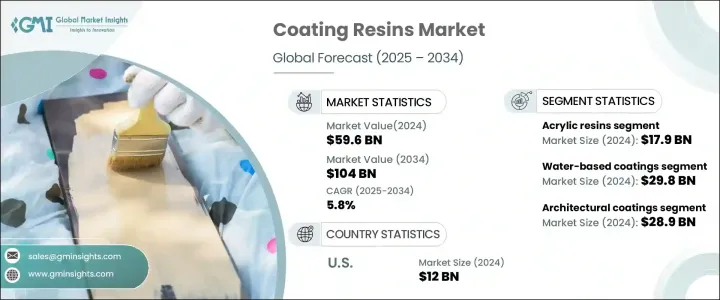
세계의 코팅 수지 시장은 2024년에 596억 달러에 달했으며, 2025년에서 2034년에 걸쳐 5.8%의 CAGR로 성장할 전망입니다.
이러한 성장은 주로 건설, 자동차, 제조 등 다양한 산업에서 코팅 수지의 적용 범위가 확대되고 있기 때문입니다. 도시화가 가속화되고 전 세계적으로 인프라 프로젝트가 계속 확장됨에 따라 건축, 자동차, 산업 분야에서 고품질 코팅에 대한 수요가 점점 더 중요해지고 있습니다. 친환경 솔루션에 대한 지속적인 요구와 함께 지속 가능한 고성능 소재로의 전환이 시장 환경을 재편하고 있습니다. 코팅 수지는 다양한 분야에서 제품의 내구성, 기능성 및 미적 매력을 향상시키는 데 필수적인 소재가 되고 있습니다. 또한 재료 기술의 발전은 혁신의 경계를 넓혀 시장의 신규 및 기존 기업에게 광범위한 기회를 창출하고 있습니다.

건설 부문에서 코팅 수지에 대한 수요는 전 세계적으로 빠르게 성장하고 있는 주거 및 상업용 건물 프로젝트의 영향을 많이 받고 있습니다. 교량과 도로와 같은 새로운 인프라 건설도 건축용 코팅제의 필요성을 높이고 있습니다. 인구 증가와 지속적인 도시화 추세로 인해 보호와 미적 향상을 모두 제공하는 코팅에 대한 요구가 증가하고 있습니다. 특히 건축 분야에 사용되는 코팅 수지는 여전히 중요한 시장 동인으로 작용할 것으로 예상됩니다. 고성능을 유지하면서 진화하는 규제 표준을 충족하는 친환경 저휘발성 유기화합물(VOC) 제형에 초점을 맞추고 있습니다.
| 시장 범위 | |
|---|---|
| 시작 연도 | 2024년 |
| 예측 연도 | 2025-2034년 |
| 시작 금액 | 596억 달러 |
| 예측 금액 | 1,040억 달러 |
| CAGR | 5.8% |
2024년 179억 달러를 차지한 아크릴 수지는 2025년부터 2034년까지 연평균 성장률(CAGR) 5.8%로 성장할 것으로 예측됩니다. 건축 부문은 아크릴 수지의 주요 소비처로, 주로 건축용 코팅제에서 아크릴 수지의 역할이 중요하기 때문입니다. 또한 이러한 수지는 제조 및 산업 부문의 지속적인 발전에 힘입어 기계, 자동차 부품 및 장비의 산업 응용 분야에서도 광범위하게 사용되고 있습니다. 고품질의 내구성 있는 코팅에 대한 강조가 증가함에 따라 다양한 산업 분야에서 아크릴 수지의 채택이 더욱 늘어날 것으로 예상됩니다.
건축용 코팅 분야는 2024년에 289억 달러가 되어 예측 기간 중에 CAGR 6.5%로 성장할 전망입니다. 이러한 성장은 글로벌 건설 활동과 인프라 투자의 급증에 기인합니다. 환경 친화적이고 지속 가능한 코팅에 대한 선호도가 계속 높아지면서 소비자와 업계 모두 기능적, 생태적 기준을 모두 충족하는 제품을 찾고 있습니다. 또한 자가 세척 및 항균성과 같은 추가적인 이점을 제공하는 혁신적인 코팅제의 개발이 주목받으면서 건축용 코팅제에 대한 수요가 더욱 증가하고 있습니다.
2024년 120억 달러 규모를 형성한 미국 코팅 수지 시장은 연평균 5.8%로 성장을 나타낼 것으로 예상됩니다. 북미의 건축용 코팅제에 대한 수요는 지속적인 주거 및 상업용 건설과 인프라 개선 및 리노베이션 프로젝트로 인해 여전히 강세를 보이고 있습니다. 도시 확장과 인구 증가도 이 시장의 성장에 크게 기여하고 있습니다. 또한 미국 자동차 부문은 생산량과 소비자 선호도의 변화에 따라 고품질의 내구성 있는 코팅에 대한 수요가 증가함에 따라 차량 코팅 시장을 주도하는 데 중요한 역할을 하고 있습니다.
The Global Coating Resins Market reached USD 59.6 billion in 2024 and is projected to experience a steady CAGR of 5.8% from 2025 to 2034. This growth is primarily driven by the expanding applications of coating resins across various industries, including construction, automotive, and manufacturing. As urbanization accelerates and infrastructure projects continue to expand worldwide, the demand for high-quality coatings in architectural, automotive, and industrial applications is becoming increasingly critical. The transition towards sustainable and high-performance materials, along with the continuous push for eco-friendly solutions, is reshaping the market landscape. Coating resins are becoming essential for enhancing the durability, functionality, and aesthetic appeal of products in diverse sectors. Moreover, advancements in material technology are pushing the boundaries of innovation, creating a broad range of opportunities for new and existing players in the market.

In the construction sector, the demand for coating resins is being heavily influenced by residential and commercial building projects, which are undergoing rapid growth globally. The construction of new infrastructure, such as bridges and roads, is also spurring the need for architectural coatings. With the rise of population growth and the ongoing urbanization trends, there is a growing requirement for coatings that offer both protection and aesthetic enhancement. Coating resins, particularly those used in architectural applications, are expected to remain a significant market driver. The focus is on eco-friendly, low-VOC formulations that meet evolving regulatory standards while maintaining high performance.
| Market Scope | |
|---|---|
| Start Year | 2024 |
| Forecast Year | 2025-2034 |
| Start Value | $59.6 Billion |
| Forecast Value | $104 Billion |
| CAGR | 5.8% |
Acrylic resins, which represented USD 17.9 billion of the market in 2024, are projected to grow at a CAGR of 5.8% between 2025 and 2034. The construction sector is a major consumer of acrylic resins, primarily due to their role in architectural coatings. Additionally, these resins are extensively used in industrial applications for machinery, automotive components, and equipment, bolstered by continued advancements in the manufacturing and industrial sectors. The increasing emphasis on high-quality, durable coatings is expected to drive further adoption of acrylic resins across various industries.
The architectural coatings segment, valued at USD 28.9 billion in 2024, is expected to expand at a robust CAGR of 6.5% over the forecast period. This growth is attributed to the surge in global construction activities and infrastructure investments. The preference for environmentally friendly and sustainable coatings continues to rise, with consumers and industries alike seeking products that meet both functional and ecological standards. Furthermore, the development of innovative coatings that provide added benefits such as self-cleaning and antimicrobial properties is attracting attention, further boosting demand for architectural coatings.
The U.S. coating resins market, which generated USD 12 billion in 2024, is anticipated to maintain steady growth at a CAGR of 5.8%. The demand for architectural coatings in North America remains strong due to ongoing residential and commercial construction, coupled with infrastructure improvements and renovation projects. Urban expansion and population growth contribute significantly to the growth of this market. Additionally, the U.S. automotive sector plays a critical role in driving the market for vehicle coatings, as demand for high-quality, durable coatings rises in tandem with production volumes and evolving consumer preferences.